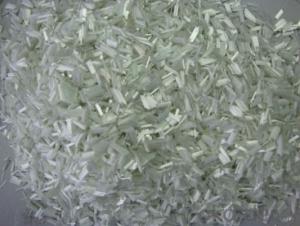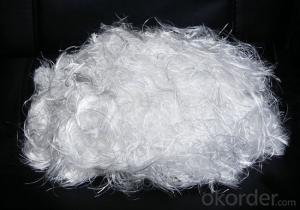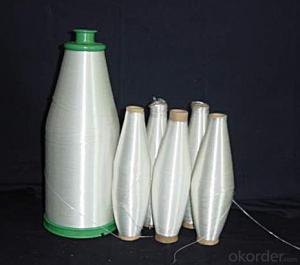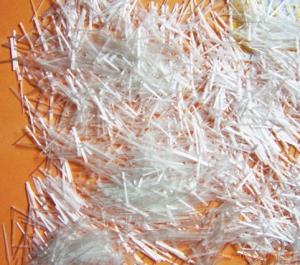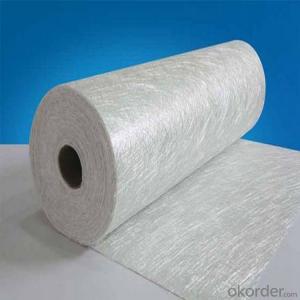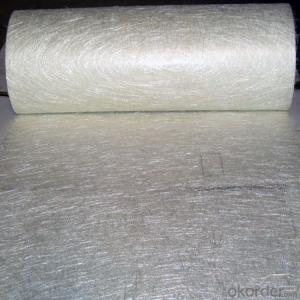E-glass Fiber Chopped Strands For BMC Usage
- Loading Port:
- Shanghai
- Payment Terms:
- TT or LC
- Min Order Qty:
- 20000 kg
- Supply Capability:
- 200000 kg/month
OKorder Service Pledge
OKorder Financial Service
You Might Also Like
DESCRIPTION:
E Glass Fiber Chopped Strands for BMC Usage are compatible with unsaturated polyester, epoxy resin and phenolic resins.
The end-use applications include transportation, building & construction, electronic & electrical, mechanical, and light industry.
Product Features:
Extremely low resin demand, delivering low viscosity to BMC paste
High impact strength; High LOI rate
High strand stiffness; Compatible with rubber
Product Specifications:
Property | Fibre diameter | Moisture Content | Size Content | Chop |
(%) | (%) | (%) | (%) | |
Mathods | IS01888 | ISO3344 | ISO1887 | |
3mm | ±10 | ≤3.0 | 0.1±0.05 | 98 |
6mm | ||||
9mm | ||||
12mm |
Special specification can be produce according to customer requirements.
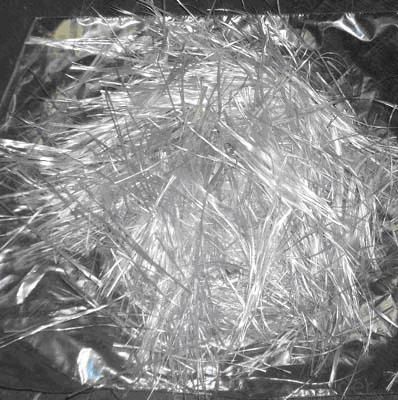
Packaging:
Each bag can be taken (15-25kgs)。 Could also take a big container bag.
Storage:
Unless otherwise specified, It should be stored in a dry, cool and rain-proof area. It is recommended that the room temperature and humidity should be always maintained at 15℃~35℃ and 35%~65% respectively.
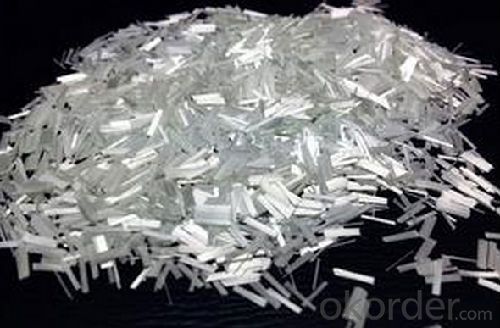
FAQ
1..Is your company a factory or trade company?
A:We have our own factory , we are on this business more than 10 years.
2.Who will pay for the express cost ?
A: We can support you free samples ,but express cost will be paid by you .
3.How long is the delivery time?
A:within 10-15 days after receiving deposit.
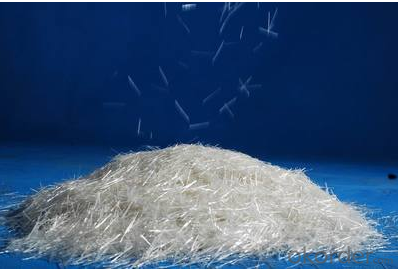
- Q:How does the orientation of fiberglass chopped strand affect its performance?
- The performance of fiberglass chopped strand is significantly influenced by its orientation. During the manufacturing process, fiberglass strands are cut into small pieces, or chopped strand, and these pieces can be arranged in various ways to achieve specific performance characteristics. The strength, stiffness, and overall mechanical properties of fiberglass composites are affected by the orientation of chopped strand. When the strands are randomly arranged, the resulting composite exhibits isotropic properties, meaning it possesses similar strength and stiffness in all directions. This random arrangement can provide satisfactory overall strength but may result in reduced performance in certain loading directions. Conversely, when the strands are aligned in a particular direction, such as in unidirectional or aligned strand mats, the resulting composite displays anisotropic properties. This implies that the composite will have different strength and stiffness properties in different directions. For instance, unidirectional composites have high strength and stiffness along the fiber alignment direction but are weaker in other directions. The orientation of chopped strand also impacts the bonding between the fibers and the resin matrix. In randomly oriented chopped strand composites, the fibers are more likely to be evenly dispersed throughout the matrix, enhancing the overall bonding and load transfer between the fibers and the matrix. On the other hand, unidirectional composites may have regions with poor bonding if the fibers are not fully impregnated with the resin. Ultimately, the orientation of fiberglass chopped strand plays a critical role in determining the performance of fiberglass composites. Manufacturers can customize the orientation to meet specific design requirements, striking a balance between desired mechanical properties and cost considerations.
- Q:How is fiberglass chopped strand used in the automotive industry?
- Fiberglass chopped strand is extensively used in the automotive industry for various purposes due to its unique characteristics and benefits. One of the primary uses of fiberglass chopped strand in the automotive industry is for reinforcing plastic parts and components. By adding fiberglass chopped strand to plastic materials, the strength, stiffness, and impact resistance of the final product can be significantly improved. This reinforcement is crucial for ensuring the durability and safety of various automotive parts, such as bumpers, dashboards, door panels, and interior trims. Additionally, fiberglass chopped strand is also used in the automotive industry for sound insulation and vibration damping purposes. The fibrous nature of fiberglass helps to absorb and dissipate noise and vibrations, making the vehicle quieter and more comfortable for the occupants. This is particularly important in reducing road and engine noise, providing a more enjoyable driving experience. Furthermore, fiberglass chopped strand is utilized in the production of composite materials, which are increasingly being used in the automotive industry. These composites, consisting of fiberglass chopped strand and a resin matrix, offer excellent strength-to-weight ratio, corrosion resistance, and design flexibility. They can be molded into complex shapes, allowing for the production of lightweight yet strong automotive parts, such as body panels, hoods, and roofs. In summary, fiberglass chopped strand plays a vital role in the automotive industry by enhancing the strength, stiffness, impact resistance, and acoustic properties of various plastic components. Its usage improves the overall performance, safety, and comfort of vehicles, while also enabling the production of lightweight and durable parts through composite materials.
- Q:How is fiberglass chopped strand used in the insulation industry?
- Fiberglass chopped strand is commonly used in the insulation industry as a reinforcement material. It is mixed with other insulation materials, such as mineral wool or foam, to enhance the overall strength and durability of the insulation product. The chopped strands help to create a more stable and structurally sound insulation material, improving its resistance to tearing, cracking, and compression. Additionally, fiberglass chopped strand also aids in preventing heat transfer, making the insulation more effective in maintaining temperature control.
- Q:How does the fiber orientation impact the properties of chopped strand composites?
- The fiber orientation in chopped strand composites plays a significant role in determining their mechanical properties. The alignment and distribution of the chopped fibers affect the overall strength, stiffness, and resistance to deformation of the composite material. A well-aligned fiber orientation can improve the composite's tensile strength, impact resistance, and dimensional stability. On the other hand, randomly oriented fibers may result in reduced mechanical properties due to weaker inter-fiber bonding and inefficient load transfer between fibers. Therefore, optimizing the fiber orientation is crucial to achieve desired performance characteristics in chopped strand composites.
- Q:What are the fire insulation properties of fiberglass chopped strand?
- Fiberglass chopped strand is a widely used material for fire insulation due to its excellent properties. It is highly resistant to heat and can withstand high temperatures without losing its structural integrity. This makes it an effective barrier against the spread of fire and heat transfer. The main reason fiberglass chopped strand is effective as a fire insulation material is its composition. It is made up of fine glass fibers that are tightly packed together. These fibers are capable of trapping air within their structure, creating a layer of insulation. This trapped air acts as a buffer against the heat and prevents its transfer to the other side of the insulation. Additionally, fiberglass chopped strand is inherently non-combustible. It does not burn or support combustion, which is a crucial characteristic for fire insulation. This non-combustible property ensures that the material will not contribute to the spread of fire and provides an additional layer of safety. Furthermore, fiberglass chopped strand has a low thermal conductivity. This means that it is a poor conductor of heat, making it an efficient insulator. It can effectively slow down the transfer of heat through its structure, protecting the surrounding areas from the high temperatures of a fire. In summary, the fire insulation properties of fiberglass chopped strand are excellent. Its ability to resist high temperatures, non-combustible nature, and low thermal conductivity make it an effective material for preventing the spread of fire and protecting surrounding areas from heat damage.
- Q:Is chopped glass fiber harmful to people?
- Classification of glass fibres:Glass fiber according to shape and length, can be divided into continuous fiber length, fiber and glass wool; according to the glass component, can be divided into non alkali, chemical resistance, high alkali, alkali, high strength, high elastic modulus and alkali resistant glass fiber etc..
- Q:How does the processing temperature of fiberglass chopped strand affect its performance?
- The processing temperature of fiberglass chopped strand directly affects its performance. Higher processing temperatures can improve the wetting and dispersion of the fibers, resulting in enhanced mechanical properties and better resin impregnation. However, excessively high temperatures can cause thermal degradation and weaken the fibers, leading to reduced performance. Therefore, finding the optimal processing temperature is crucial to achieve the desired performance characteristics in fiberglass chopped strand.
- Q:How does the length of fiberglass chopped strand affect its performance?
- The length of fiberglass chopped strand can have a significant impact on its performance. Generally, chopped strand lengths range from a few millimeters to several centimeters. Firstly, the length of the chopped strand affects the strength and stiffness of the final composite material. Longer strands provide higher strength and stiffness, as they have more contact points with the resin matrix. This enables the material to withstand higher loads and stresses. On the other hand, shorter strands may result in reduced strength and stiffness, making the composite material more flexible and less rigid. Secondly, the length of the chopped strand affects the processing and handling characteristics of the material. Longer strands can be more difficult to mix and disperse evenly in the resin matrix, leading to potential issues such as clumping or poor wet-out. In contrast, shorter strands tend to mix more easily and uniformly, resulting in improved processing and a higher quality end product. Additionally, the length of the chopped strand can influence the surface finish of the composite material. Longer strands may protrude from the surface, causing a rougher texture and potentially affecting the aesthetics of the final product. Shorter strands, on the other hand, tend to be more embedded within the resin matrix, resulting in a smoother and more uniform surface finish. Finally, the length of the chopped strand can impact the cost and efficiency of production. Longer strands tend to be more expensive and require more processing steps, such as cutting or chopping, to achieve the desired length. Shorter strands, on the other hand, are typically more cost-effective and require less processing time. In summary, the length of fiberglass chopped strand plays a crucial role in determining the strength, stiffness, processing characteristics, surface finish, and cost of the final composite material. It is important to carefully consider the specific requirements of the application in order to select the most appropriate chopped strand length for optimal performance.
- Q:How is the moisture resistance of fiberglass chopped strand ensured?
- The moisture resistance of fiberglass chopped strand is guaranteed by a combination of elements. Initially, a special resin or sizing is applied to the individual glass fibers during the manufacturing process to repel moisture. This coating acts as a barrier, preventing water from penetrating the fibers and causing damage. Moreover, fiberglass chopped strand is frequently utilized in applications that offer further protection against moisture. For instance, it is commonly used as a reinforcing material in composite products like fiberglass-reinforced plastics (FRP) or fiber cement boards. These composite materials provide an additional layer of protection against moisture since the resin matrix or cement matrix used in these products is inherently resistant to water. Additionally, the mechanical properties of fiberglass, including its high strength-to-weight ratio and dimensional stability, contribute to its moisture resistance. Fiberglass chopped strand is renowned for its exceptional resistance to warping, swelling, or rotting when exposed to moisture or humidity. In conclusion, the moisture resistance of fiberglass chopped strand is ensured through a combination of its inherent properties, manufacturing processes, and protective measures taken in the applications where it is employed.
- Q:How is the quality of fiberglass chopped strand ensured?
- To ensure the quality of fiberglass chopped strand, a rigorous manufacturing process and multiple quality control measures are employed. To begin with, great care is taken in selecting the raw materials for the production of fiberglass chopped strand to ensure their purity and consistency. High-quality glass fibers and resin binders, the primary raw materials, are sourced from reputable suppliers who adhere to strict quality standards. During the manufacturing process, specialized equipment is used to chop the glass fibers into specific lengths. These chopped fibers are then treated with a sizing agent, carefully formulated to enhance their adhesion to the resin matrix and optimize their performance. Following the chopping and treatment of the fibers, samples are taken from each batch and subjected to various physical and mechanical tests. These tests include measuring fiber diameter, length, tensile strength, moisture content, and compatibility with the resin. The purpose of these tests is to ensure that the fibers meet the required specifications and are suitable for use in a range of applications. Moreover, the finished fiberglass chopped strand undergoes additional quality control checks. These checks encompass visual inspection, sampling, and testing for mechanical properties such as tensile strength, flexural strength, and impact resistance. These tests are conducted to guarantee that the final product meets the necessary quality standards and performance criteria. Furthermore, manufacturers often implement a quality management system, such as obtaining ISO 9001 certification, to maintain consistent quality control throughout the production process. Regular audits and inspections are carried out to verify compliance with the established quality management system and identify areas for improvement. Overall, the quality of fiberglass chopped strand is assured through a meticulous selection of raw materials, stringent manufacturing processes, comprehensive testing, and adherence to quality management systems. These measures serve to ensure that the final product meets the required specifications and delivers optimal performance across various applications.
1. Manufacturer Overview |
|
|---|---|
| Location | |
| Year Established | |
| Annual Output Value | |
| Main Markets | |
| Company Certifications | |
2. Manufacturer Certificates |
|
|---|---|
| a) Certification Name | |
| Range | |
| Reference | |
| Validity Period | |
3. Manufacturer Capability |
|
|---|---|
| a)Trade Capacity | |
| Nearest Port | |
| Export Percentage | |
| No.of Employees in Trade Department | |
| Language Spoken: | |
| b)Factory Information | |
| Factory Size: | |
| No. of Production Lines | |
| Contract Manufacturing | |
| Product Price Range | |
Send your message to us
E-glass Fiber Chopped Strands For BMC Usage
- Loading Port:
- Shanghai
- Payment Terms:
- TT or LC
- Min Order Qty:
- 20000 kg
- Supply Capability:
- 200000 kg/month
OKorder Service Pledge
OKorder Financial Service
Similar products
New products
Hot products
Related keywords


